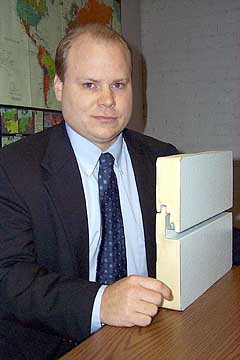|
Subscribe / Renew |
|
|
Contact Us |
|
| ► Subscribe to our Free Weekly Newsletter | |
| home | Welcome, sign in or click here to subscribe. | login |
Construction
| |

June 15, 2000
Siding panels use gravity to keep the rain out
Whistling winds pose more of a threat to big buildings than meets the eye, especially in the damp Northwest.
Pressure builds up outside of a building when the wind howls. So, if the siding isn't designed properly, the pressure will effectively suck moisture through the siding, wreaking all sorts of havoc, explains Ron Laramie, a Northwest salesman for Centria Architectural Services.

|
Calking seals off that problem, but engineers have also designed a calk-free joint system that "uses gravity and the forces of nature to keep water out," said Laramie. He described the method as the rain screen principal.
Pennsylvania-based Centria has sold on average of $4 million to $5 million in commercial building exterior metal panels and windows per year in the Northwest for the past few years, said Laramie.
The panels cover the new Seahawks stadium exhibition hall and the new University of Washington Oceanography Building and are going on the Metropolitan Park III office building under construction on the north end of downtown Seattle. They also cover some Boeing buildings, such as the wind tunnel building.
Centria's leading metal panel is a foam-insulated model called the Formawall Dimension Series, typically associated with suburban-style buildings "with a high-tech look," as Laramie put it.
"We came out with the dimension series this past year. It's our lead horse," Laramie said. "We've changed the joinery so we can bury the reveal of the panels, from a quarter-inch up to six inches. You can also put color in those reveals, or a different metal. It allows architects to do certain lines."
The panels weigh less than three pounds per square foot. Their thickness can vary and they work with recessed windows, according to Centria.
Centria produces the panels but doesn't install them. "We sell to dealers such as Kenco Construction and Crown Corr," Laramie said.
Centria, which also produces wall, roof and floor systems for commercial buildings, was created in 1996 through the merger of Pittsburgh companies H.H. Robertson and Smith Steelite. Robertson had a presence in the Northwest that it brought to the merged company.
The development boom of the past few years hasn't significantly boosted Centria's Northwest sales volume yet, Laramie said.
"We're starting to see more volume, yeah," he said. "But we're not really into the highrise buildings over 20 stories. Our bread and butter companies are like Boeing and chip manufacturing plants, and you've seen a downturn in those in the past few years."
Also, he said, "it seems like architects like different products at that size (highrise buildings), like a plate or concrete or stone."
Previous columns:
- Company has the poop for keeping birds away, 06-08-2000
- Creating a little desert indoors, 06-01-2000
- Living in a cardboard house, 02-24-2000
- $17 million emergency center spurred by fire training tower, 01-13-2000
- Landscape problem? Cover it with a 'rock', 01-06-2000
- Life on the leading edge of sustainability, 12-23-1999
- Commuter Building now a traffic-stopper, 11-18-1999
- Permeable pavement can reduce storm runoff, 11-04-1999


